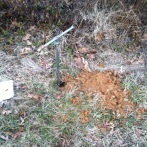Using a Backhoe vs an Auger for Soil Evaluations
The site and soil evaluation is the first step toward certifying or permitting an onsite waste water disposal system (septic system). During the evaluation, the consultant gathers detailed information about the property and surrounding parcels. Information collected includes landscape characteristics, soil properties, separation distances and owner’s preferences. This information is collected to determine if a potential site can effectively treat and dispose of waste water effluent in a safe and sanitary manner. Suitability of soil for a septic system is determined by reviewing three to five soil profiles within the absorption area. A backhoe is used mainly in Northern Virginia and the Shenandoah Valley to expose these profiles. In this region shallow rock fragments and bedrock are common. If soils on the property are mapped with minimal rock content and county regulations permit, we will attempt to use a hand auger. Using an auger can be risky because if a Soil Evaluator or an Environmental Health Specialist is unable to bore because of rock or stoniness, then they have to assume that is where impermeable lithic bedrock begins. Since a backhoe can remove loose rocks and stones, it is more accurate in exposing the true soil profile. Although a backhoe will cost the homeowner more money upfront, they will have an accurate septic system design for their property. Conventional and alternative septic systems can vary in cost ranging in $8,000-$30,000. One of the main factors that determine costs is depth to bed rock. ...
Read More
